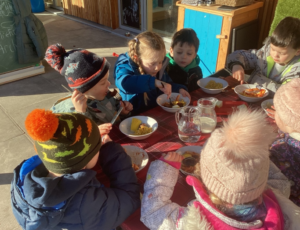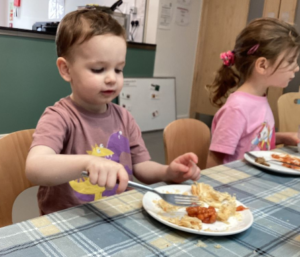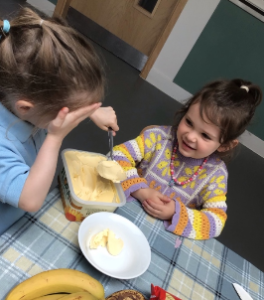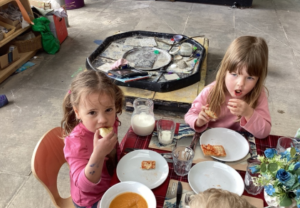‘The term ‘meal’ is often understood to mean a cooked meal with vegetables, but breakfast cereal with milk and orange juice, or just a cheese and tomato sandwich with a glass of milk, is just as much a meal as shepherd’s pie and peas. A meal is, therefore, any significant contribution to daily nutritional intake. It is important to offer a variety of tastes, textures and temperatures.’ (Setting The Table, 2014)
“Food is a good way to express care and nurturing” (Setting the Table 2014 pg. 8)

This quote is what we at Overlee see as the aim for our children. We want snack and lunch times to be a positive, caring and nurturing experience for everyone involved.
At Overlee we ensure that our mealtimes incorporate the following:
- Promotes children’s choice and voice
- Relaxed and unhurried atmosphere
- Role modelling
- Homelike and nurturing environments
- Positive social experiences for all
- Positive associations with food
Cooking and baking experiences
- Health snack and mealtimes
- Positive Interactions
Children make choices around the fruits and vegetables that they would like at snack times at Bob’s Bistro. Our children select, wash, chop, serve, eat and tidy all our snacks and have developed a sense of pride in Bob’s Bistro. Our snack’s are health promoting and encourage our children to try fruits and vegetables.
Health and Social Care Standards
1.25 I can chose to have an active life and participate in a range of recreational, social, creative, physical and learning activities every day, both indoors and outdoors.
1.33 I can choose suitably presented and healthy meals and snacks, including fresh fruit and vegetables, and participate in menu planning.
1.35 I can enjoy unhurried snack and meal times in as relaxed an atmosphere as possible.
1.36 If I wish, I can share snacks and meals alongside other people using and working in the service if appropriate.
1.37 My meals and snacks meet my cultural and dietary needs, beliefs and preferences.
1.38 If appropriate, I can choose to make my own meals, snacks and drinks, with support if I need it, and can choose to grow, cook and eat my own food where possible.
2.24 I make informed choices and decisions about the risks I take in my daily life and am encouraged to take positive risks which enhance the quality of my life.
What the Approach Looks Like at Overlee.
At ‘Bob’s Bistro’ we create an environment that encourages a ‘home-like’ environment for all our children to enjoy and feel a part of. We recognise that children’s experience of mealtimes can be instrumental in developing life long relationships with food. Our children have opportunities to develop independence and self-help skills while sitting with their peers in a relaxed environment.
Food Matters shares UNICEF’s core message and vision – If a child receives the right nutrition and care at the start of their lives they’ll grow up healthy and strong – and there’s no limit to what they can become.
Health and Social Care Standards – ‘I can enjoy unhurried snack and meal times in as relaxed an atmosphere as possible’.
Toddlers and Young Children: Food, mood and health guidance 2020 (P14) – Some young children are slow eaters and need to be given time and flexibility to enjoy and eat their food.
With these statements in mind, within Overlee we offer a free -flow lunch as our children make choices around when they are hungry, when they are ready to eat their lunch in an unhurried, calm and relaxed setting that promotes children’s Independence and social interactions. All children are supported to feel safe and secure in an environment which is built on a positive strength based high quality learning environment. Their needs are met with dignity and respect by staff who understand child development and the importance of nurturing approaches. Staff reflect their knowledge of current documentation in their practice.

Each child has a place at the table with a plate, cutlery, bowl and a glass with the food in the centre of the table to encourage the children to self serve and to pass the serving dishes round to create a ‘home from home’ feeling. The children have various options for lunch including soup, crudités a main course and salad. The adults eat alongside the children to model good eating and healthy relationship with food. Gentle music is playing on a record player in the corner, soft lighting and flowers in the middle of the table add the finishing touches to our calm, relaxed dining experience.
When the children are finished eating they are encouraged to add any food waste into our food waste bin to promote a responsible attitude to food waste. Children then wash their dishes in a soapy basin and ensure that they have cleaned the table. When the eating area is cleaned the children use a warm face cloth to wash their face and feel freshened ready to play.
Planning the menu
Toddlers and Young Children: Food, mood and health guidance 2020 (P16) – Children are more attached to foods that they have grown, purchased or prepared.
- Menus, shopping lists for snacks will be planned with children.
- All foods will be photographed which children can use to make choices.
- There will be a recipe station with cook books/prior menus for children to access for inspiration for menus.
- There will always be one alternative available especially on days when lunches are not popular.

Encouraging ‘intuative eating‘
Intuitive eating is an eating method that has been studied for quite some time now. Some people may not have realised that they have been practising intuitive eating most of their lives until they come across this term. Intuitive eating is an evidenced-based, mind-body health approach that focuses on learning to trust your inner body senses, such as hunger and fullness cues, and to make choices around food that feel good in your body. What about children in particular? Can children practice intuitive eating like adults? Absolutely! Most of us are naturally born intuitive eaters. The reality is that intuitive eating can be for everyone. As infants, we have used our instinctive hunger and fullness cues while being breast-fed or bottle-fed. At about six months, infants are usually introduced to solid foods, and the same instincts are practices. However, after about two years of age, certain environmental changes can interfere with a child’s intuitive eating skills. Those interference may come from eating from boredom, being influenced by someone else’s eating habits, food advertisements, or eating food to cope with emotions. Here are a few tips to help your child continue with their intuitive eating skills as they grow into adults.
Setting the Table (P80) – Childcare is an environment where children can establish healthy eating patterns.
Food Matters (P3) – Support children to eat well and have positive relationships with food.
This will help children to recognise when they are hungry and when they are full
- Giving the children a choice of when they want to eat and how much food they would like.
- Giving the children plenty of time to eat at their own pace
- Children will be encouraged to try foods on offer.
Creating a setting
- Making it warm, bright and comforting experience
- The mealtime area will create a home-like, inviting and relaxed atmosphere
- There will be photos on the wall.
- The area will have a clear flow system (clear pathways/consistent routine)
Involving the children
- Children will set the table for mealtimes.
- Children will always be involved with preparation/cooking/baking foods.
- Children plate up their own food

Snack/Lunch Time Routine
- Morning snack is a from 9:30am- 10.30am.
- Afternoon snack is something simple such as a fruit bowl or something the children have prepared earlier in the day such as homemade bread or rolls.
- Children will self-serve at mealtimes. This encourages independence although adults support children with this when required.
- Clean up station. Children are encouraged/supported by staff to empty leftovers into food waste bin (promote re-cycling), wash dishes then place into the basin.
- All children will have suitable meals prepared for them e.g. allergies/dietary requirements.
- Children have a choice of milk or water with meals. Water is always available throughout the day.
Outdoor Snack and Mealtimes
At Overlee our children have the option to eat indoors or out. We discuss our play, socialise with our peers and there is always space for the baby’s high chair at the table all while the children develop their independence and self help skill. #qualitymealtimes @FroebelTrust 🥰 pic.twitter.com/TxoH0O6QgS
— Overlee Family Centre (@OverleeFc) March 1, 2023
Children have the freedom to choose to eat their lunch and snacks in the outdoor areas and have a specific area in which to do this. The children will cover the picnic table with the waterproof table cloth and set the spaces with the coasters and place settings ready for eating. The children will come indoors to the hand-washing sinks inside to wash their hands before lunch and will be supported by the staff members inside. The children will then have the opportunity to enjoy an unhurried meal experiences in the outdoor environment and engage in social time with their peers. Staff within the outdoor environment will probe the food outside prior to serving to ensure the correct food temperatures are maintained.
The children will make choices around eating indoors or outdoors and can decide where they wish to eat. The opportunities and experiences that are offered to children in the indoor area are equitable in the outdoor area and children have the same mealtime opportunities in all areas of the nursery.
Risk Assessments
Using the food temperature prob we ensure that the food is served at a ‘safe’ temperature of 65 – 70 degrees. The food is also regularly probed throughout the mealtime experience to ensure the ‘safe’ food temperature is maintained and if the food drops below this temperature then it is replaced with food at the safe temperature. The Care Inspectorate guidance on ensuring the safety of children during meal and snack times are incorporated into the Risk Assessments.
The ‘Support’ member of the lunch team regularly checks these temperatures and ensures that the food and drinks are always topped up and available to the children throughout the mealtime.

